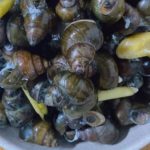1. What is Mẻ
Mẻ, also known as “cơm mẻ,” is a traditional spice in Vietnamese cuisine. This traditional spice has a sour and fragrant taste that is used in many dishes such as hotpots, braised dishes, sour soups, bún riêu (crab noodle soup), buffalo meat cooked with fermented rice, and snails cooked with fried tofu and green banana.
Mẻ is very beneficial for health
Mẻ is nutritious, rich in protein, amino acids, and vitamins. It is not only a spice that enhances the unique flavor of the dish, but also brings health benefits to the consumer such as promoting appetite, stimulating digestion, and providing some beneficial nutrients for the digestive system.
2. Some notes when using Mẻ
When using Mẻ, pay attention to the following:
- Avoid eating too much Mẻ, as it can cause symptoms of stomach pain and diarrhea due to the excess production of lactic acid in the body.
- Avoid eating Mẻ in general and dishes that contain Mẻ in particular for people with stomach pain or gastric ulcers.
- If Mẻ is not prepared properly, it can promote the growth of bacteria and mold, especially mold fermentation in rice (before using it to make Mẻ), which can be harmful to health. However, mold fermentation during the Mẻ fermentation process is beneficial for your health.
- Before consuming, check if the Mẻ has mold. Signs that Mẻ has mold include: no distinctive aroma, no natural sour taste, and strange color.
3. How to nurture and use Mẻ for a long time
It is not difficult to nurture Mẻ, if you feel that Mẻ is almost running out, you just need to leave a small amount in a glass jar. After that, add cooked white rice (thickly cooked), or fresh vermicelli, or leftover rice. Then, cover it tightly and leave it for a few more days, then continue to use it when there are signs of fermentation with the distinctive sour taste and aroma.
In addition, when the fermented rice reaches a certain level of sourness, you can smell it to check. At this time, use dry and clean utensils to scoop it into a separate bowl. Then, add water, stir, strain, and use the filtered liquid. You can even crush a small amount of Mẻ through a sieve, marinate it for some dishes or use it for cooking.
References from yeutre.vn and pasgo.vn.
Exploring the Benefits of Chia Seeds on Good Health: What You Need to Know
 Health: What You Need to Know’>
Health: What You Need to Know’>Did you know that chia seeds come from the same family as herbs that are used in spices such as mint and basil? These seeds are a popular health food due to their unique health benefits. Read on to find out how these seeds can be used and why they're so beneficial!





































